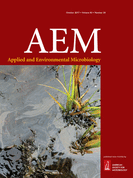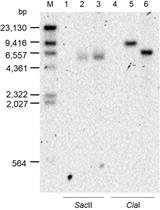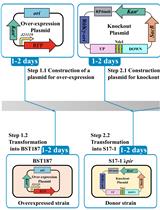- EN - English
- CN - 中文
Induction of Natural Competence in Genetically-modified Lactococcus lactis
转基因乳酸乳球菌自然感受态的诱导
发布: 2018年07月05日第8卷第13期 DOI: 10.21769/BioProtoc.2922 浏览次数: 7736
评审: Modesto Redrejo-RodriguezAdison WongAlba Blesa
Abstract
Natural competence can be activated in Lactoccocus lactis subsp lactis and cremoris upon overexpression of ComX, a master regulator of bacterial competence. Herein, we demonstrate a method to activate bacterial competence by regulating the expression of the comX gene by using a nisin-inducible promoter in an L. lactis strain harboring either a chromosomal or plasmid-encoded copy of nisRK. Addition of moderate concentrations of the inducer nisin resulted in concomitant moderate levels of ComX, which led to an optimal transformation rate (1.0 x 10-6 transformants/total cell number/g plasmid DNA). Here, a detailed description of the optimized protocol for competence induction is presented.
Keywords: Natural competence (自然感受态)Background
Natural competence is the process in which a bacterium acquires exogenous DNA via a specialized uptake machinery after which the internalized DNA is either integrated into its genome or maintained as plasmid DNA. Several bacteria enter a state of competence upon specific environmental triggers such as genotoxic stress or starvation (Seitz and Blokesch, 2013; Blokesch, 2016). Quorum sensing systems such as comCDE or comRS control the activation of natural competence in Gram positive bacteria (Håvarstein et al., 1995; Pestova et al., 1996; Kleerebezem et al., 1997b; Fontaine et al., 2015). More specifically, comC and comS encode pheromones, whereas comD encodes a histidine kinase and comE and comR encode response regulators (Håvarstein et al., 1995; Pestova et al., 1996; Fontaine et al., 2010; Fontaine et al., 2015). In streptococci, the activated regulator drives transcription of the alternative sigma factor ComX, which in turn, activates transcription of competence genes that encode the proteins encompassing the DNA uptake machinery (Johnston et al., 2014). Previously, strategies employing overexpression of ComX led to the successful introduction of exogenous DNA in Streptococcus thermophilus (Blomqvist et al., 2006) and L. lactis (David et al., 2017; Mulder et al., 2017), even though different approaches were employed to achieve its overexpression. These studies also showed that different expression levels of comX critically impact on transformation rates. For example, in our work we used L. lactis subsp. lactis KF147, a strain that allows Nisin-Controlled gene Expression system (NICE) (Mierau and Kleerebezem, 2005) and harbors chromosomal nisRK (essential to allow nisin induction) but does not produce nisin. In this strain, we introduced pNZ6200, a vector containing comX under the control of the nisin-inducible nisA promotor, by electro-transformation, and the resulting strain was not transformable upon full comX induction (2 ng/ml nisin), whereas optimal transformation rates (1.0 x 10-6 transformants/total cell number/g plasmid DNA) were observed upon moderate levels of induction (0.03 ng/ml nisin) (Mulder et al., 2017). Moreover, we also demonstrated that applying the same strategy worked for a nisRK derivative of L. lactis subsp. lactis IL1403, whereas competence induction in L. lactis subsp. cremoris KW2 required prior transformation of the strain with pNZ9531 that expresses nisRK (Kleerebezem et al., 1997a) to allow nisin induced expression of comX. In order to assess whether other L. lactis strains can become naturally competent, we hereby provide a method containing all details of the competence protocol as described previously (Mulder et al., 2017) that can assist other scientists to unleash competence in the L. lactis strain of their interest and might prevent experimental issues concerning nisin induced expression of ComX. This newly developed protocol is expected to allow genetic access in a broad panel of L. lactis strains with an efficiency that enables rapid-one-step construction of gene replacement mutants via integration of linear DNA fragments harboring an antibiotic resistance marker flanked by chromosomal homologous DNA regions.
Materials and Reagents
- Pipette tips
- 15 ml and 50 ml CELLSTAR® Polypropylene Tube (conical) (Greiner Bio One International, CELLSTAR®, catalog numbers: 188271 and 227261 respectively)
- Plastic Petri dish 94 x 16 with vents light version (Greiner Bio One International, catalog number: 633181 )
- 12 ml Cell Culture Tubes (Greiner Bio One International, CELLSTAR®, catalog number: 163160 )
- Inoculation loops
- Eppendorf Tubes® Safe-Lock Tubes 1.5 ml (Eppendorf, catalog number: 0030120086 )
- Electroporation cuvettes, 2 mm gap (Bio-Rad Laboratories, catalog number: 1652086 )
- Semi-micro cuvettes for 1 ml (for optical density measurements)
- Bacterial strains: L. lactis strain of interest with a complete set of competence genes, L. lactis harboring pNZ6200 (Mulder et al., 2017), pNZ6202 (Mulder et al., 2017), and pNZ9531 (Kleerebezem et al., 1997a)
- M17 broth (M17) and M17 agar (M17A) (Tritium, catalog numbers: M086.76.0200 and M085.76.0200 respectively)
- Glucose solution (20%, Tritium, catalog number: G209.65.0080 )
- Distilled water (Thermo Fisher Scientific, GibcoTM, catalog number: 15230089 )
- Stock solutions of antibiotics:
20 mg/ml chloramphenicol (Sigma-Aldrich, catalog number: C0378-100G )
20 mg/ml erythromycin (Fisher Scientific, catalog number: BP920-25 )
12.5 mg/ml Tetracycline hydrochloride (Sigma-Aldrich, catalog number: T7660-25G ) - NisinA® P Ultrapure Nisin A (Handary, Brussels, Belgium, prepare a 2 mg/ml stock solution in distilled water containing 0.05 glacial acetic acid)
- Alternatively: nisin from Lactococcus lactis 2.5% (Sigma-Aldrich, catalog number: N5764 )
- JETSTAR 2.0 Maxiprep Kit (GENPRICE, catalog number: 220 020 ) or PureLinkTM HiPure Plasmid Maxiprep Kit (Thermo Fisher Scientific, InvitrogenTM, catalog number: K210007 )
- QubitTM dsDNA BR Assay Kit (Thermo Fisher Scientific, InvitrogenTM, catalog number: Q32850 )
- Phenol BioUltra, for molecular biology, TE-saturated, ~73% (T) (Sigma-Aldrich, catalog number: 77607 )
- Chloroform HPLC grade, ≥ 99.9% (Sigma-Aldrich, catalog number: 528730 )
- Ethidium bromide (Sigma-Aldrich, catalog number: E1510-10ML )
- Agarose tablets (U.S. Biotech Sources, catalog number: G01PD-500 )
- Glacial acetic acid (Scharlab, catalog number: AC03522500 )
- β-glycerophosphate (Disodium salt) (Sigma-Aldrich, catalog number: 50020-500G )
- Potassium phosphate dibasic (K2HPO4) (Merck, catalog number: 1.05104.1000 )
- Potassium phosphate monobasic (KH2PO4) (Merck, catalog number: 1.04873.1000 )
- Na-acetate (Merck, catalog number: 1.06268.1000 )
- (NH4)3-citrate (Sigma-Aldrich, catalog number: A1332-500G )
- Ascorbic acid (VWR, AnalaR NORMPAPUR®, catalog number: 20150.231 )
- Manganese(II) chloride tetrahydrate (MnCl2·4H2O) (Sigma-Aldrich, catalog number: M8054-100G )
- Adenine (Sigma-Aldrich, Fluka, catalog number: 01830 )
- Guanine (Sigma-Aldrich, catalog number: G11950-100G )
- Uracil (Sigma-Aldrich, Fluka, catalog number: 94220 )
- Xanthine (Sigma-Aldrich, catalog number: X7375-10G )
- Alanine (Sigma-Aldrich, catalog number: A7627-100G )
- Arginine (Sigma-Aldrich, catalog number: A5006-500G )
- Aspartic acid (Sigma-Aldrich, catalog number: A9256-100G )
- Cysteine-HCl (Sigma-Aldrich, catalog number: C1276-250G )
- Glutamic acid (Sigma-Aldrich, catalog number: G1251-500G )
- Glycine (Merck, catalog number: 1.04201.0250 )
- Histidine (Sigma-Aldrich, catalog number: H8000-100G )
- Leucine (Sigma-Aldrich, catalog number: L8000-100G )
- Lysine (Sigma-Aldrich, catalog number: L5626-100G )
- Methionine (Sigma-Aldrich, catalog number: M9625-100G )
- Phenylalanine (Sigma-Aldrich, catalog number: P2126-100G )
- Proline (Sigma-Aldrich, catalog number: P0380-100G )
- Serine (Sigma-Aldrich, catalog number: S4500-100G )
- Threonine (Sigma-Aldrich, catalog number: T8625-100G )
- Tryptophane (Sigma-Aldrich, catalog number: T0254-100G )
- Valine (Sigma-Aldrich, catalog number: V0500-100G )
- Magnesium chloride hexahydrate (MgCl2·6H2O) (Sigma-Aldrich, catalog number: M2670-100G )
- Calcium chloride dihydrate (CaCl2·2H2O) (Merck, catalog number: 1.02382.0500 )
- Zinc sulfate heptahydrate (ZnSO4·7H2O) (Sigma-Aldrich, catalog number: Z0251-100G )
- Cobalt(II) sulfate heptahydrate (CoSO4·7H2O) (Sigma-Aldrich, catalog number: C6768-100G )
- Copper (II) sulfate pentahydrate (CuSO4·5H2O) (Scharlab, catalog number: CO01010500 )
- Ammonium molybdate tetrahydrate ((NH4)6Mo7O24·4H2O) (Sigma-Aldrich, Fluka, catalog number: 09878 )
- Iron(II) chloride tetrahydrate (FeCl2·4H2O) (Sigma-Aldrich, catalog number: 44939-50G )
- Hydrochloric acid (HCl) (Sigma-Aldrich, catalog number: 30721-1L )
- Iron(III) chloride hexahydrate (FeCl3·6H2O) (Sigma-Aldrich, catalog number: F2877-100G )
- p-aminobenzoëic acid (Sigma-Aldrich, catalog number: A9879-100G )
- Inosine (Sigma-Aldrich, catalog number: I4125-25G )
- Orotic acid (Sigma-Aldrich, catalog number: O2750-100G )
- Pyridoxamine-HCl (Sigma-Aldrich, catalog number: P9380-5G )
- Thymidine (Sigma-Aldrich, catalog number: T9250-10G )
- D-biotin (Sigma-Aldrich, catalog number: B4501-5G )
- 6,8-thioctic acid (Sigma-Aldrich, catalog number: T5625-5G )
- Pyridoxine-HCl (Sigma-Aldrich, catalog number: P9755-25G )
- Folic acid (Sigma-Aldrich, catalog number: F7876-25G )
- Nicotinic acid (Sigma-Aldrich, catalog number: N4126-5G )
- Ca-(D+)pantothenate (Sigma-Aldrich, catalog number: P5155-100G )
- Riboflavin (Sigma-Aldrich, catalog number: R4500-25G )
- Thiamin-HCl (Sigma-Aldrich, catalog number: T4625-100G )
- Vitamin B12 (Sigma-Aldrich, catalog number: V2876-5G )
- Alternatively, PCR product (obtained with KOD hot start DNA polymerase)
Note: Containing an antibiotic resistance marker flanked by chromosomal fragments for integration obtained by using overlap PCR (Horton et al., 1990) if preferred over plasmid transformation, e.g., for the construction of gene replacement mutants. - Optional: KOD hot start DNA polymerase Master Mix (Merck, Novagen, catalog number: 71842-4 )
- GSGM17 (see Recipes)
- Washing solution 1 (see Recipes)
- Washing solution 2 (see Recipes)
- Recovery medium (see Recipes)
- CDM (see Recipes)
- GCDM (chemically defined medium supplemented with glucose) (see Recipes)
- Stock solutions for CDM (see Recipes)
- Nucleotide solution
- MnCl2·4H2O solution
- Amino acid solution
- Metal solution
- Iron solution
- Vitamin solution
- Nucleotide solution
Equipment
- General pipettes
- 200 ml bottle
- Water bath (for 30 °C and 55 °C)
- Incubation stove at 30 °C
- Vortex
- Autoclave
- Microcentrifuge (Eppendorf® Refrigerated Microcentrifuge) (Eppendorf, model: 5417R )
- Centrifuge for 15 and 50 ml tubes (Heraeus Megafuge 1.0R)
- Qubit® 2.0 Fluorometer (Thermo Fisher Scientific, InvitrogenTM, mode: Qubit® 2.0 )
- Electroporator (Bio-Rad Laboratories, model: GenePulserXcellTM )
- Spectrophotometer (Genesys 10 UV Spectrophotometer)
- Nanodrop ND1000 spectrophotometer (NanoDrop Technologies) (Thermo Fisher Scientific, model: NanoDropTM 1000 )
Procedure
文章信息
版权信息
© 2018 The Authors; exclusive licensee Bio-protocol LLC.
如何引用
Mulder, J., Wels, M., Kuipers, O. P., Kleerebezem, M. and Bron, P. A. (2018). Induction of Natural Competence in Genetically-modified Lactococcus lactis. Bio-protocol 8(13): e2922. DOI: 10.21769/BioProtoc.2922.
分类
微生物学 > 微生物遗传学 > 转化
分子生物学 > DNA > 转化
您对这篇实验方法有问题吗?
在此处发布您的问题,我们将邀请本文作者来回答。同时,我们会将您的问题发布到Bio-protocol Exchange,以便寻求社区成员的帮助。
Share
Bluesky
X
Copy link













